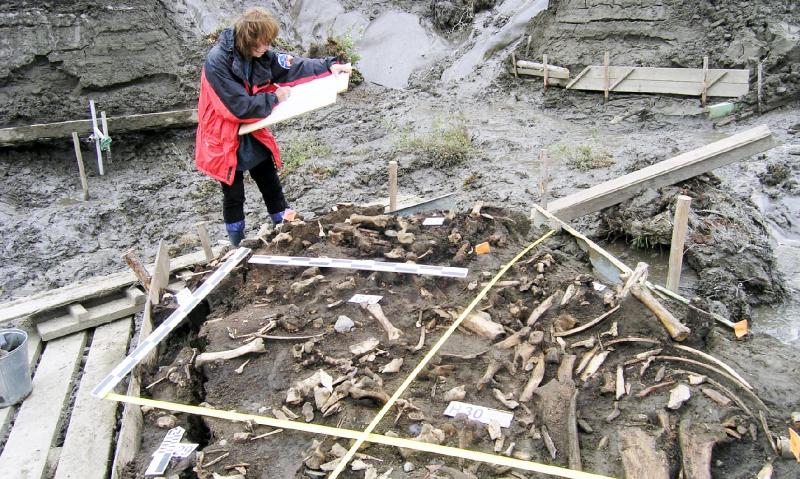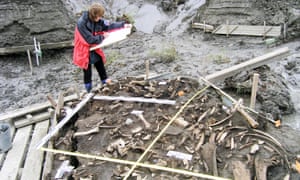Ancient Siberia was home to previously unknown humans, say scientists


DNA analysis reveals hardy group genetically distinct from Eurasians and East Asians

The archaeological site near the Yana River in Siberia where two 31,000-year-old milk teeth were found. Photograph: Elena Pavlova/Nature
It was cold, remote and involved picking fights with woolly mammoths – but it seems ancient Siberia 30,000 years ago was home to a hardy and previously unknown group of humans. Scientists say the discovery could help solve long-standing mysteries about the ancestors of native North Americans.
While it is commonly believed the ancestors of native North Americans arrived from Eurasia via a now submerged land bridge called Beringia, exactly which groups crossed and gave rise to native North American populations has been difficult to unpick.
Now scientists say they might have found some answers to the conundrums.
Writing in the journal Nature , Eske Willerslev and colleagues reveal how they drew on existing data from modern populations as well as analyzing ancient DNA from the remains of 34 individuals obtained from sites around north-eastern Siberia, dating from more than 31,000 years ago up to 600 years ago.
The key remains were fragments of two tiny human milk teeth, shed by males, found at a place in Russia called Yana Rhinoceros Horn Site. First excavated in 2001, the site offers the earliest direct evidence of humans in north-eastern Siberia, with finds also including bone items and stone tools. Indirect evidence of human populations in north-eastern Siberia goes back to more than 40,000 years ago.
This iframe is not allowedWhile it had previously been thought that these remains might be from the ancestors of native North Americans, the DNA data suggests otherwise.
“What we see here is a much more complex story than what we believed was the case,” said Willerslev, director of the Lundbeck Foundation Centre for Geogenetics at the University of Copenhagen.
The results reveal these individuals were part of a previously unknown yet widespread group, dubbed the Ancient North Siberians by the team, who were genetically distinct from both Western Eurasians and East Asians. The researchers say they split off from the former 38,000 years ago – in other words, very shortly after Western Eurasians and East Asians themselves became genetically distinct. “They were living as big game hunters of woolly mammoth and woolly rhinoceros,” said Willerslev.
But, crucially, this population does not appear to be the direct ancestor of Native Americans .
Instead, analysis of the collection of genomes suggests the population that became the ancestors of native North Americans was the result of liaisons about 20,000 years ago between East Asians, who traveled north, and a group distantly related to the Ancient Northern Siberians. The East Asians also mixed with other descendants of Ancient Northern Siberians to give rise to another group, who the team dubs the Ancient Paleo Siberians, who went on to supplant the existing group.
“[Ancestors of] Native Americans are not the first people in north-eastern Siberia as most people, if not everybody thought,” said Willerslev, adding that DNA recovered in north-eastern Siberia from what is believed to be an Ancient Paleo Siberian was crucial to the work. “This is the first evidence we have, real evidence, of something very close genetically to Native Americans,” he said.
The team adds that one possibility is that the mixing involving the East Asians occurred in southern Beringia – one of the areas that could have offered respite from harshening conditions at the time.
The Ancient Paleo Siberians were themselves supplanted by another band of East Asians heading north about 10,000 years ago that gave rise to a group dubbed the “Neo-Siberians”. “The vast majority of the genetic makeup of present day Siberians comes from this last push,” said Willerslev. “This is also the reason you don’t have any very close connection between contemporary Siberians and Native Americans.”
John Hoffecker from the University of Colorado Boulder, who was not involved in the study, welcomed the research, saying a striking feature of the study is that humans were faring well in north-eastern Siberia, even in very difficult conditions, 30,000 years ago – with the genetic data from the teeth suggesting the males belonged to a population of about 500 people.
“That’s a pretty healthy population,” he said. “We had no idea 30 years ago that we had this robust healthy hunter-gatherer population thriving up in the high Arctic 30,000 years ago – it is amazing.”
Hoffecker added the presence of the group suggests it was the ice sheets in North America, not hostile conditions in Beringia, that kept people from reaching the Americas sooner.




An unknown group of people from Siberia adds more mystery to the origins of Native Americans.
I'm sticking with my mishomis and nookomis (grandfather and grandmother). It's a nice exercise but.we've always been here...
You know Kavika, one of my favorite lecturers, Nick Zentner from Central Washington University often states earth and biological scientists work in stove pipe environments.
They more often fail to connect the dots of other disciplines and sub-disciplines in their respective research areas.
This is a very interesting article and provides more keen insights which may lead to many more doors to open in the future.
For example, there have been archaeological finds in northern South America dating back prior to the time of these newly discovered people.
That tells me, there were people here more than 30K - 31K years ago.
A lot of advances have been made in the methods of discovery. I wonder how breaking down the stove pipes may help the sciences see even greater advances?
Keep in mind too, NASA tells us, the seas have risen 120M in the past 25K years.
I am thinking, just like today, many folks lived along the shore line and much of our history is hidden under the seas waiting for discovery.
JMO
I agree dave, there seems to be a blind spot with many of the scientists.
There have been some recent discoveries off the shore of the U.S. and Mexico that are astounding. I'm sure that there are many more in water just waiting to be discovered.
With the recent advances we have seen on the land and the fast pace at which they are coming, I hope I am around more of the under sea discoveries.
There was a discovery off the coast of Florida last year of an ancient Indian burial ground. It was pretty much intact even though in was in deep ocean water. It had been protected by peat moss.
Amazing discovery.
Very interesting Kavika.
The peat bogs are amazing things.
A few years ago some Mayan finds were discovered off shore, again with the wooden stakes. Though, I don't recall there being any human remains present. Other artifact were discovered.
I wonder, if instead of Seminole ancestors, is it possible the Taino may have reached that area?
I remember reading about that and the wooden stakes. That was really an interesting find.
It's possible that the Taino made it to Florida.
I love Nick Zentner! He's fascinating and fun. Good to know another NT'r knows what I know. I hope to see him lecture in person this winter.
That would be great.
He does such a good job of engaging the audience.
My other 2 favorite are:
Bettany Hughes - "Classical" History. Though she mentioned some time ago a planned series of the pre Columbian Americas . Not to be confused with Bethany Hughes of the US.
Alice Roberts - Evolutionary Biology.
All excellent instructures and speakers.
I will definitely look into the others. Thanks for sharing that info.
I think we've seen every youtube he's put out. Some even a few times. I love his road trips as I know the highways and byways like the back of my hand.
I take it you're in WA State too? Our nephew and his wife just moved to Ellensburgh, so we'll be spending more time there than we have. Hubby used to live there in his younger years before we met. And I worked that area quite a bit in my former work life too.
We are on West Puget Sound. Actually heading east here for a road trip over the North Cascades again in a few weeks. Have friends in Winthrop, then over to Leavenworth for October Fest. Then a few days with the kids in Eburg. That trip never bores me. Nick has made it even more interesting viewing the terrain in a whole different light.
I hope you enjoy them.
Be aware that neither Bettany's or Alice's lectures are cataloged like Nick's are, so some youtube or similar searching is in order.
It must be enjoyable to drive through the area Nick lectures about. I am on the east coast in Maryland.
I learned about Nick in a round about way, pursuing several Ice Age catastrophes all of which resulted in flooding across the earth on a scale not witnessed today.
In particular I was concerned about the impact on early Native American peoples and secondarily on the peoples in the Black Sea region. A lifetime of study could be devoted to either.
When I came across Nick, I quickly realized I had stumbled across a resource beyond what I could have possibly imagined. Wow. I wish I could find a similar resource for the floods that dumped out in to the Atlantic or Artic...still not sure which way those went.
Never stop learning.
Never stop learning, you know it! Just found out we can see 2 lectures by Nick the 10th and 11th of October. Going to be fun!
Fantastic.
Uh Oh, you are on the hook now to bring stories back!!!
No, seriously, have a good time there.
Dear Friends: Good and thoughtful posts all.
Well done.
Brother Kavika: Please keep these informative articles coming.
P&AB.
Enoch.
Ever since I saw the movie Jurassic Park many years ago, and the cloning of a sheep (was it called "Dolly"?) I have wondered if it were possible to actually grow a man and woman from DNA from the bones of ancient humans that are found.
Interesting question. Perhaps at a later date, no wait, not going there.
Maybe we would have to resurrect Dr. Frankenstein.
So true. We don't have that many later dates left.
I think that it could be done. I've heard that the geneticists are trying to do it with a Mammoth (to be gestated in a female Elephant). Best place to get active DNA is in the teeth. Obviously, a Mammoth tusk would provide a lot of DNA. While it could technically be done (the human genome has been charted), they may have ethical problems working with homo sapiens, or even a close relative.
Yep. It was Dolly. I've heard that she grew up, was bred with a male sheep and the mixture bred true (no genetic damage).
I would be willing to wager a pretty large sum that there are a lot more lost cultures that are still lost than there are those that have already been found or still exist.
The cloning or attempted cloning of a human would really bring some moral/ethical questions into play.
I think that cloning is duplicating something that already exists. I was thinking more about growing something from DNA, as they did in the movie Jurassic Park.
I believe that even growing from the DNA would bring into question the moral/ethical questions, Buzz.
Yeah, I guess it would just lead to more discrimination. I can hear it now: "Would you let your daughter marry a Neanderthal, even if he was a star NFL fullback?"
Wow, sorry I missed this earlier. Totally cool findings. I think that the more we dig, the clearer the picture of the past we get. I know that this will add to the roots of Indians here in the Americas.. and you are right, there is more hidden in the shallows.
Then maybe only The Shadow knows...